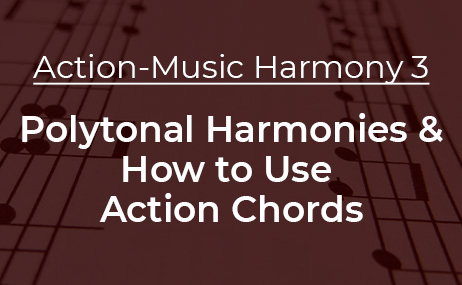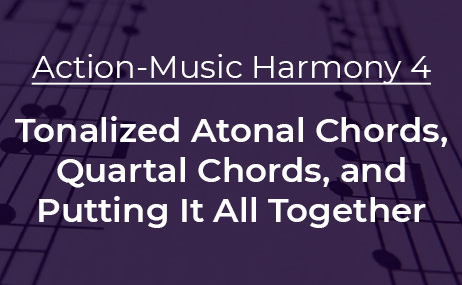These lessons focus on the three main scales of classic action music: octatonic, hexatonic, and Hungarian minor. Learn how to extract sophisticated action writing from them with easy-to-understand techniques. Lesson 4 builds a vocabulary of common chords from hexatonic and Hungarian minor scales. Lesson 5 then demonstrates how scales play an important part in the planing of chords. And Lesson 6 reveals common ways of mixing the action scales together, either one after the other or even at the same time!
The course comes with a set of composition exercises with answers that are in MIDI format for DAWs, MusicXML for notation software, and PDF for pencil and paper. You can also get feedback directly from the instructor by posting your answers in the site forums. And review content quickly and easily with the Quick References section.
Note: While the Octatonic course is not required to take this course, it is recommended as some aspects of the Hexatonic course build on the Octatonic course.
Hexatonic Course Breakdown
Lesson 4 – Hexatonic and Hungarian Minor Scales
- Hexatonic Scales
- Overview
- Tonal Chords, 3 notes (major and minor)
- Tonal Chords, 4 notes (mM7 and augM7)
- Atonal Chords, 5 and 6 notes
- Melodies and Flourishes
- Hungarian Minor Scales
- Overview + Tonal Chords (3 and 4 notes)
- Main Chord, 5 notes
- Tonal Chords, 5 notes (add2 chords)
- Atonal Chords, 5 to 7 notes
- Atonal Chords, 3 notes, (the (014) chord)
- Melodies and Flourishes
Lesson 5 – Planing and Pedal Point
- Planing as a Concept
- Overview
- Typical Planed Chords
- Planing a Chord through a Scale
- Minor Scales
- Modes
- Octatonic Melodies Harmonized by Planed Chords
- Minor Chords
- Major Chords
- With One Scale Note Changed
- Planing and Pedal Points
- Combined Melody-Bass “Chords”
- Increasing the Dissonance between Planed Chords and Pedals
Lesson 6 – Combining Scales Together
- Juxtaposing Action Scales
- Octatonic + Hungarian Minor
- Hexatonic + Hungarian Minor
- Octatonic + Hexatonic
- Mixing Action Scales with Non-Scale Notes
- Octatonic + 1 Note
- Octatonic Melody Harmonized by Chords of a Single Type
- Simultaneous Action Scales
- Octatonic as Gap Filler for Hexatonic
- Harmonies from One Scale Organized by Another
Join Our Mailing List
Receive an email when a new course or blog post becomes available.
By subscribing, you agree with our Privacy Policy.




